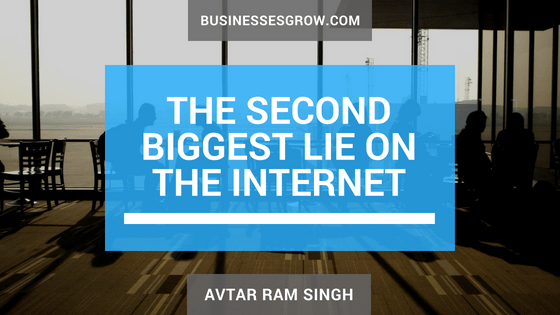
By Avtar Ram Singh, {grow} Contributing Columnist
It’s said that the biggest lie on the internet is a consumer saying, “I have read and agree to the terms and conditions.”
The second biggest lie on the internet is a brand saying, “We value your feedback.”
There’s an incredibly popular ride-hailing service that I frequently use. Like most ride-hailing services, you can order a private ride, a shared ride or an executive class ride. When I feel like treating myself, or after a long day of work – I order an executive class ride.
Sometimes the fancy car from this service doesn’t really scream “luxury.” It’s an old model, or a model that just about qualifies to be in the executive class, and doesn’t really feel “executive.”
At the end of each trip, you’re asked to rate the experience. I drop the service a note and let them know that the specific car model is perhaps not suited for an executive ride, or that the car was an incredibly old one.
A few seconds after submitting that feedback, I always get an e-mail saying, “We value your feedback.” Then there’s a standard reply about how someone will get back to me, or address my concerns.
I’ve sent a message about that particular repeated experience at least 12 times in the last three years.
No one has ever got back to me.
I’ve never received a single, “Sorry about the experience, but we investigated the car – and it meets our executive class requirements” or even a, “Stop whining about silly things”.
I’d have been happy with either.
What I’m not happy with, is an auto-responder that says, “We value your feedback” and the brand goes on to categorically prove to me that in fact — they don’t.
The Significance of Feedback
I’m sure I’m not the only one that feels that way about a service. Tons of people have reached out to airlines, telephone companies, banks, their local bakery — and been told that their feedback is valued, and yet — it never really feels like it is.
Now obviously a company can’t change an entire process or a product feature purely because one customer out of thousands doesn’t like it.
But, are they even aware that it’s just one customer out of thousands that doesn’t like it?
Marketing today is increasingly measured in reach, likes, retweets, leads, traffic – so on and so forth. Due to the amount of brands that assail customers with content these days, tangible feedback is often hard to come by. Seldom will a customer type out a well thought out criticism or thought on a feature, service or product.
But when it happens most organizations recognize it as gold.
The Signal in the Noise
A fairly common occurrence on a brand’s Facebook page is comments that have nothing to do with the content posted. A restaurant posts something about a special offer for the weekend, and they get a comment from a customer that was appalled with the level of customer service he was offered the last time he visited the restaurant.
A bank posts a video of a the features of a new credit card, and the post gets 50+ comments from people saying they hate the hidden fees the bank charges, or how long they’re kept on hold.
The brand usually responds with, “Let’s take this into private message” or something of the sort, where the futile conversation continues.
How often does this happen?
Are brands and marketers really tracking what is being talked about in the comments section of social media, or are they too busy making sure every query is responded to within 27 minutes so that they meet their customer service KPIs?
Very few brands truly analyse the comments they receive on a weekly or monthly basis via social media (or any other platforms) to uncover the key problems being highlighted by their customers, and then take steps to rectify them.
The Value for Brands and Consumers Alike
I’ve done this for multiple brands over the last few years, but extracting value from feedback, and extracting the signal from the noise when it comes to comments and critique from customers can be a fairly straightforward process, but one that demands discipline.
- Categorize feedback based on business unit, product, service – or whichever category best gives you insight on how your company conducts business.
- Export and log these comments in a shared access document, that can be seen by different departments within your organisation – this is key.
- Pay close attention to which business units / products / business lines get the most amount of feedback, and why. Analyse month-to-month rises in feedback across units to understand whether or not this month is an outlier.
- Categorize feedback by customer ID / name / e-mail address if you need to. Eight people giving feedback about the same thing deserves the same amount of attention as one person giving the same feedback eight times.
- Flag and follow-up on the feedback with relevant business unit owners. Remember, this isn’t a marketing problem – it’s a business problem. You’ll probably need C-Suite buy-in for this and for them to flag this as important to make some headway, so pull the right strings.
- Make sure a canned response is not the last piece of communication any customer gets for any kind of feedback.
There are plenty of tools and services out there that are able to collate feedback from across platforms for you in order for it to be not too manual a process, but if you have start with an Excel that’s manually updated – then so be it.
The Brand’s Signal
At the end of the day, you may not be able to take action for some feedback. A customer might make unreasonable demands, another might have misread a situation, some might be in the wrong.
The cost to send them a message, or to pick up the phone and call them and spend 30 seconds saying, “Hey, we heard you — but here’s why it works that way” is insignificant.
The cost to tell a customer their feedback is valued, and to ignore their feedback is incredibly significant. It’s a signal of mistrust. That the brand will say whatever needs to be said.
And in your next PR crisis, when you tell your side of the story, all consumers will hear, is what they think the brand feels needs to be said.
 Avtar Ram Singh is the Head of Strategy at FALCON Agency, a performance-led, business results oriented marketing agency that operates in South East Asia. He’s built marketing strategies and performance frameworks for brands on global and regional levels, across a variety of industries. You can find him on LinkedIn, and Twitter.
Avtar Ram Singh is the Head of Strategy at FALCON Agency, a performance-led, business results oriented marketing agency that operates in South East Asia. He’s built marketing strategies and performance frameworks for brands on global and regional levels, across a variety of industries. You can find him on LinkedIn, and Twitter.


